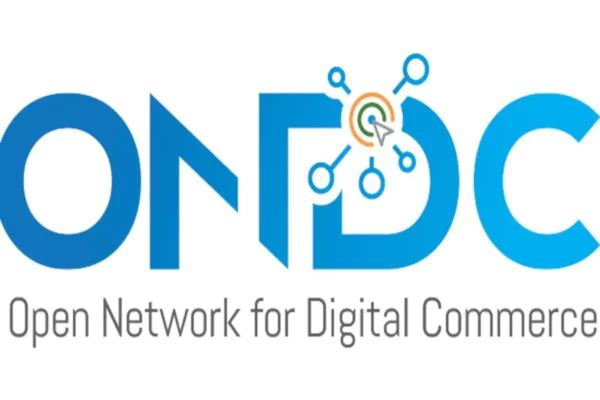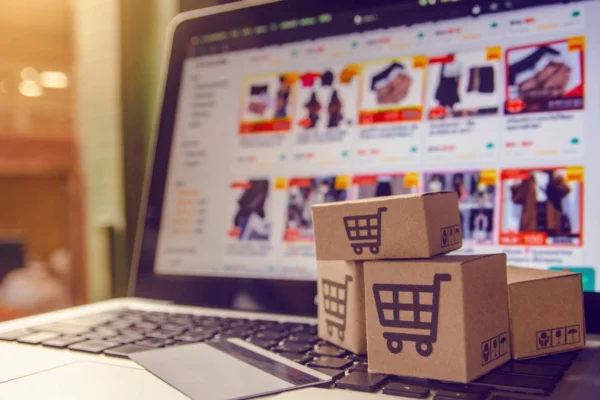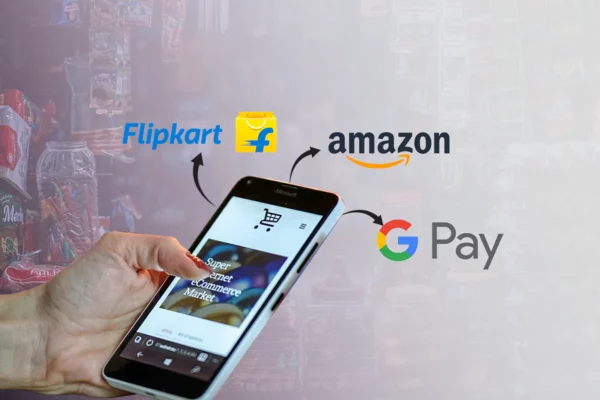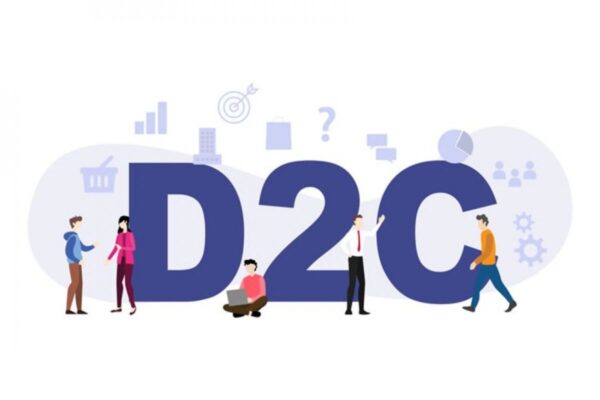How India’s Bold ONDC Venture Can Reinvent Indian Ecommerce?

How India’s Bold ONDC Venture Can Reinvent Indian Ecommerce?
The Tremendous effort by the Indian government to democratize online commerce said as ONDC will soon go online.
The ONDC will increase e-commerce penetration from its present 10% share of India’s retail industry to 40–50% during the coming years: Shireesh Joshi, the ONDC’s CBO
Despite the enthusiasm, the mission faces a number of problems, including knowledge gaps, scale limitations, technology problems, and data protection concerns.
It is expected that the Open Community for Digital Commerce (ONDC), a government effort in India, will make the community usable by the public. This groundbreaking effort has been dealt with as the UPI second of Indian eCommerce since the test phase started in April of this year.
With more than 60% of the country’s online retail sector controlled by companies like Amazon India and Walmart-owned Flipkart, it’s expected to put about 8 million small and mid-size businesses on an equitable playing field.
Even better, if it is implemented globally, it brings about honest competition in retail.
The non-profit industry, which is sponsored by DPIIT (the Division for Promotion of Trade and Inside Commerce), will bring all stakeholders together on one platform for comfort and advancement, buyers, sellers, logistics players, and digital fee providers.
As the United Funds Interface (UPI) democratized the digital fund sector, it will help businesses create a level playing field and promote open trade. Customers will benefit from easy access to a large provider base, great pricing, quicker delivery, and improved customer experience.
Similar to how NPCI is in charge of the $10 Tn market for digital payments with more than 103 Bn transactions since 2016, ONDC aims to generate 3 Bn orders every month, bring 15 Bn local businesses online, add 900 Mn digital consumers, and reach a gross merchandise value (GMV) of $48 Bn over the next five years. By the end of August or the beginning of September 2022, ONDC is expected to be available in more than 100 Indian cities.
Local retailers, which clash with internet behemoths over fees and commissions, have been affected by the excitement. Up to 200 sellers from cities in round 15 have already signed up for the ONDC challenge, and the number is growing.

Strangely, rumour has it that ONDC will keep referral commission caps at 3-5% at a later time (for now, it’s free), significant cost savings over what businesses have to pay for online product promotion. According to a Gofrugal estimate, that is 7–10 times less than the typical online selling fee of 23%–28% on the cart value.
In contrast, e-commerce continues to be a matter of religion for certain customers from the perspective of the consumer. The number of web connections has increased to around 830 Mn in 2021, which ONDC deems a potential e-commerce market.
It states that only 4-5% of this market has been taken up by current e-commerce players, whereas facts show that this number is actually 22%. But the two biggest online retailers, Amazon and Flipkart, combined control more than 60% of the 190 million internet shoppers in the market today.
Microsoft is the first of the several Big Tech companies operating here to join the ONDC project because it plans to release a social commerce app in India and wants to use the open community to find the best prices on supply. The US-based tech giant dubbed the “community recreation changer” and a win-win situation for both buyers and sellers, ending reliance on any e-commerce solution.
Despite the media’s and the public’s positive spin, there are many detractors, while others take a wait-and-see approach. The founder and CEO of a financial company with headquarters in Mumbai, with brick-and-mortar retailers and Kirana stores in Tier 2 and Tier 3 locations, thinks ONDC is a broken mannequin.
Decoding The ONDC Framework
A platform, piece of software, an aggregator, or a super app is not what ONDC is. It serves as a generic company that provides a community or protocol for communication.
By transforming digital commerce from a platform-centric model to an open community for all parties involved and facilitating online order fulfilment between a customer and vendor, this community seeks to democratize it.
It means that buyers and sellers will be able to be monitored and engaged by an open community via digital techniques, however their business or the platform or software they use. If there is a customer and a seller has a list of products or businesses from which a choice can be made, the ONDC protocol will function.
It is largely a peer-to-peer (P2P) community with some B2B (business-to-business) functionality.”Regardless of prior knowledge or expertise, anyone may join the community and start their path toward digital commerce. Manoj Gupta, CEO and founder of Plotch.AI and Craftsvilla, said during one of his ONDC events, “That’s the amazing part about our platform.
ONDC Vs Present Ecommerce Transaction Structure

Now that everyone is familiar with the fundamental principles of open e-commerce, let’s look at the transactional variations. The backend of traditional e-commerce platforms handles operations, while the storefront serves consumers. The latter may be related to a group of vendors or suppliers.
An e-commerce market acts as a mediator and arbitrator by bringing buyers and sellers together through its storefront and backend.
Although the chance to market online to a huge customer base can ensure great growth, the benefits of this business model are mostly enjoyed by a number of big players in control of the e-commerce platforms.
On the other hand, ONDC wants to break up the current system and provide the benefits of democratic advertising, embedded e-commerce, and market-regulated pricing to a sizable community of vendors, customers, and buyer-facing platforms.
Being a communication hub, ONDC makes it possible to look for and find every company that has registered here.
It has set up a registry where all buyer apps—such as Paytm and PhonePe—and seller apps—such as Amazon, Flipkart, and several small retailers—would enter their data, including location name, GST number, firm PAN, and authorised signature, among other things. This ensures that the community will only include authorised platforms.
By the way, a status ledger has been set up to track business rankings based on these criteria, and ONDC reserves the right to decide who is allowed to deliver services and who is not. To help businesses move their goods, a community for logistics suppliers has also been added.
Purchaser apps will take care of a variety of tasks such as product discovery and search, order generation and confirmation, management of special offers and carts, payment, ONDC registration, and more. Similar to how things are now, only customer applications will be accountable for resolving customer complaints in the event of returns or refunds.
Vendor apps will include those created by specific retailers. As an alternative, local businesses can band together to form a subnet of producers and retailers in a neighbourhood or smaller city and register as a single vendor app (eSamudaay vendor app).
These apps will manage ONDC registration, respond to first product availability-related search queries, deal with dynamic pricing, and manage logistics and payments.
HOW ONDC WILL WORK? (BUYER-CYCLE)
An alert is sent to the vendor app after the customer completes the cart and places the order. The vendor then sends the address to the order page. Order confirmation and payment are followed by the vendor app receiving verification of the order.
When purchasing multiple items from various vendors, they will initially see a single cart, but each seller will receive a separate notification. A vendor app can find a suitable logistics partner from the community after a published transaction.
Who Is Constructing ONDC Tech
According to Joshi of ONDC, the project is now run by an internal tech team that has created demo applications for customers and sellers to test the new apps businesses are developing.
The Beckn APIs, a collection of open community protocols provided by Bengaluru-based NPO Beckon Basis, is used by the ONDC specifications to communicate over HTTP.
The 58 ONDC transaction use cases covered by these protocols range from search to payment options to returns and refunds to rankings. A free-to-use, open, interoperable protocol definition is being developed by Beckon.
Each requested pair is seen as a “contract” between two events since ONDC transactions are considered to be commercial in nature. All appeals and callbacks must be digitally signed by the sender and proved by the recipient. It is fascinating that the communication is not altered or interfered with while it is in transit.
By the way, the in-house tech team isn’t delivering any extra assistance to developers creating these applications beyond the demo apps and integrating the new customer and vendor apps into the ONDC Registry.
Therefore, e-commerce SaaS enablers from Chennai and Mumbai, Gofrugal and Plotch.AI, respectively, have stepped in to help develop the new apps using the Beckn algo and keeping in mind the requirements of ONDC standards.
Glitches At The Tech Finish
All back-end suppliers registered in that city will get the gateway forward search request from a back-end application in accordance with the existing ONDC specifications.
Simply put, if a consumer from East Delhi searches for green tea on a buying app, all vendor apps in the city are possible to receive a search request from the customer.
Any Delhi-based sellers listed with the ONDC Registry may thereafter send inquiries to the chosen buyer. This data will probably be automatically gathered from the vendor apps in accordance with agreed location-based requirements.
Similar to a customer exploring pizza or restaurants on Swiggy, the results may be anywhere between 1 and 20 kilometres away from the customer. Nevertheless, from the standpoint of the ONDC, this will be difficult.
Long-term perspective could be a short-term issue: Vendor applications are in charge of a lot of data since they collect queries from across the city. These may experience numerous non-coverage locations due to location, cost, and turnaround time while dealing with problems.
Although this information will eventually help businesses expand their stores and services, it will be difficult to monitor the dashboard in real-time for the most relevant search requests or hire a data analytics company to draw useful conclusions from the data.
The dilemma of several carts:

According to Gupta of Plotch.AI, a customer may add four things from four distinct sellers, each with a different timeframe for delivery. Since the entire day will probably be spent answering doorbells, the outcome is never acceptable.
In contrast, switching to modern services like Blinkit, Zepto, BigBasket, or Swiggy Instamart will be more convenient because, unlike ONDC, these markets allow users to place membership orders and send the same thing at once.
“In this competition for exposure and quantity, every business will try to fulfil as many demands as possible, sellers may bite off more than they can chew.” There are a number of ways that something could go wrong before that is fixed,” according to a business expert.
‘Deep’ Networks, New ‘Low cost’ Wars Could Plague ONDC
Terabytes have been written on how small shops are now at the whim of wealthy giants like Amazon, Flipkart, and their ilk due to the exorbitant commissions and aggressive cost-cutting practices of e-commerce marketplaces.
The technology may also help “place” shops and their products for better visibility. To democratize “the marketplace,” ONDC seeks to eliminate all of that. Surprisingly, though, the old problems can resurface soon in a different form.
To begin with, an overpopulated ecosystem may cause even a moderately enjoyable location to see drastic value declines. It is unclear how the open platform, with a low entry barrier, can control the price war at online marketplaces given the search-to-response ratio on ONDC.
Will the federal government set price-cut limits based mostly on the model size? Will there be new limits for hyperlocal or big, medium, and small distributors? Or new regulations for those who benefit from economies of scale, together with a low-cost exception for the rest who have yet to succeed there and are currently having trouble paying for digital transformation?
What’s extra worrying is the presence of the deep-pocketed e-commerce giants.
The Confederation of All India Merchants (CAIT) and other business advocacy groups have been raising red flags about the tactics used by the major e-commerce marketplaces for a very long time.
These institutions can easily use a variety of tools and strategies to their advantage now that they are a part of a brand new platform without clarity regarding potential price wars, harming small businesses in the process.
Additionally, they will stand out from the competition due to their access to a large network of logistics companies, their well-honed skills, such as low-ticket-size e-selling and delivery, 10-minute delivery, and years of customer trust-building around simple returns and refunds.
One has to question what else Amazon and Flipkart might be able to sell on the new platform while they are joining ONDC to set up vendor apps. This will probably be acceptable because e-retailers can set up both buyer and vendor apps on ONDC.
If Amazon and Flipkart follow suit, there will undoubtedly be many advantages. If that occurs soon, they would start charging commissions on purchases as buyer apps, while the vendor apps developed by these businesses will achieve a scale never before seen.

Given that they already account for more than 25% of their overall sales, it makes sense that their private brands will be important this time. There may not be a better way to contact Bharat through ONDC given that each is known for pushing their own labels to make them into powerful brands.
Strangely, each buyer app essentially shares the vendor registration on ONDC. The entire list may thus become a source of aggressive and predatory marketing pitches for any company that has a vendor listing that is comparable to that found in the Yellow Pages.
As a result, Amazon and Flipkart, which use a subscription-plus-commission business model to enrol vendors, can use the registration to pay for more than 7.9 Mn SMEs across the nation.
Another question that has to be answered is whether or not the merchants selling on Amazon and Flipkart will be registered on the ONDC Registry. This could lead to more privacy issues involving the sharing of transaction-level data and other performance metrics.
Trade sources claim that the merchandise will list as Amazon and Flipkart on the customer app rather than individual merchants. In this way, it will be possible for e-commerce behemoths to keep their vendors’ information private and to themselves.
However, that might just be one more link in the chain of e-streamlined commerce methods. The new chain will probably be buyer – buyer app – vendor app (Amazon/Flipkart), whereas the current chain is buyer – e-commerce app – vendor. However, the federal government hasn’t yet included a clause to this effect.
A different group of competitors will likely participate in ONDC’s digital combine. These are the offline, well-funded FMCG competitors ITC, Dabur, and Unilever, who are now in talks with ONDC.
Is it possible that SMEs would continue to play second fiddle in the e-commerce war zone as opposed to Amazon versus Flipkart and Amazon-Flipkart versus offline retail giants? Will ONDC actually usher in a small-retail revolution, or will it snuff out India’s newly discovered excitement for digital-first D2C manufacturers?
Can India Do A Taobao Powered By ONDC?
Ecommerce in India has witnessed several dramatic changes during the past twenty years. The primary business model has used various sets of levers to keep up with changing circumstances from the beginning of online commerce in 1999 with
Fabmart to the successful launches of Flipkart and Snapdeal in 2007 and 2010, respectively, to the rise of D2C in the wake of the Covid-19 pandemic in 2020.

It has served as the starting point for a variety of industry niches and business models, including hyperlocal and quick commerce, online groceries, food delivery, logistics technology, e-commerce SaaS, and dukaantech, among others.
The expansion tale was fantastic. The market is expected to reach $400 billion by 2030 and is home to 23 unicorns valued at $28.72 billion, 1.8 thousand active businesses, 128 million internet users, and around 3 million registered merchants and service providers.
However, as Joshi of ONDC told Inc42, active businesses in this sector currently only cover less than 10% of the overall retail market. ONDC is the solution to closing this gap. The other 90% of the population (who do not use e-commerce) can be brought into the digital fold by the ONDC protocol, he continued.
Online retail in India is inclusive, which has the potential to usher in new business trends like Taobao in China.
This market, which is owned by Alibaba, provides a platform for small businesses and lone entrepreneurs to create online shops and largely cater to the Chinese-speaking populace at home and abroad while payments are made online. That is exactly what ONDC hopes to accomplish but in an open community.
After all, critics provide quite different examples. Although companies like CRED, Paytm Mall, and MobiKwik have tried their best, many believe that turning every consumer-facing platform into a market hasn’t been entirely successful in this case. Simply said, the amount of “embedded e-commerce” at this level is far from exciting.
The important thing to note here is that a serious attempt was made for the first time. Local business associations should be included in the effort, and necessary steps can be made to raise awareness and strengthen the capacity of various stakeholders, as identified by Piyush Goyal.
In addition, many players in the service sector, including gig workers, agripreneurs, insurers, and others, can use the ONDC protocols to connect with their target audiences, broadening the project’s scope.
For instance, ONDC and the National Bank for Agriculture and Rural Development (NABARD) are working on a program to introduce the public to the agriculture industry with the idea that ONDC could also be a helpful tool to assist farmers in locating the right prices for their produce.
For a very long time, India has struggled to provide a single Agri market for all agricultural and related products. However, the solution is probably no longer difficult to find.
Despite the fact that the challenge is a Centre initiative, state governments are also joining hands to push it across India. The ONDC has held seminars with the governments of Tamil Nadu and Kerala and is in communication with numerous states.
Additionally, it assisted the Uttar Pradesh government in setting up an ODOP bazaar on the platform. More states will eventually open their marts to promote local craftsmen and the retail ecology.
It won’t be easy to free e-commerce from its current constraints. However, India only did it once when it introduced BHIM-UPI in 2016 to democratize the process of making digital payments. The UAE, Nepal, and Bhutan have all embraced the technology in less than six years, and Singapore is poised to follow suit later this year.

The agro team, producers, startups, SMEs, and a number of other various categories are among the organizations with which we are actively collaborating, according to Joshi.
Can ONDC produce another locally acclaimed success story that goes global? Following its official debut in a public context, it will be interesting to watch how it develops.
edited and proofread by nikita sharma




